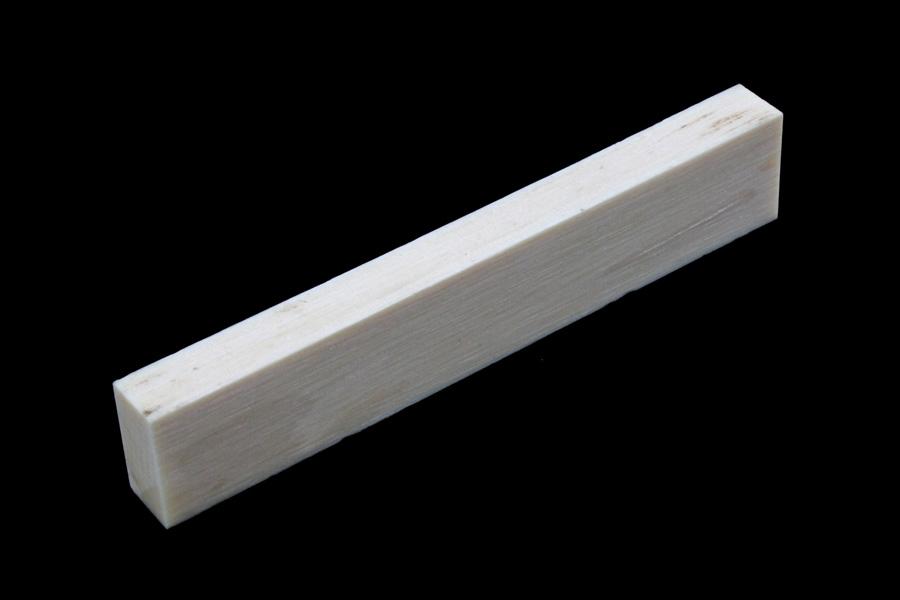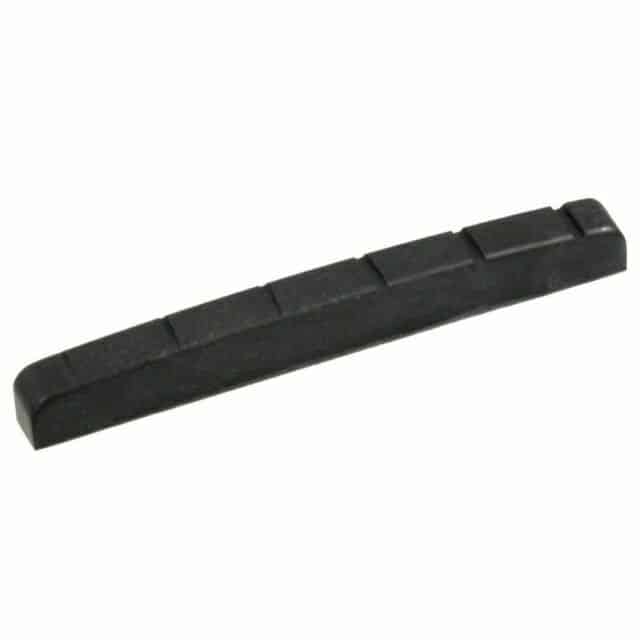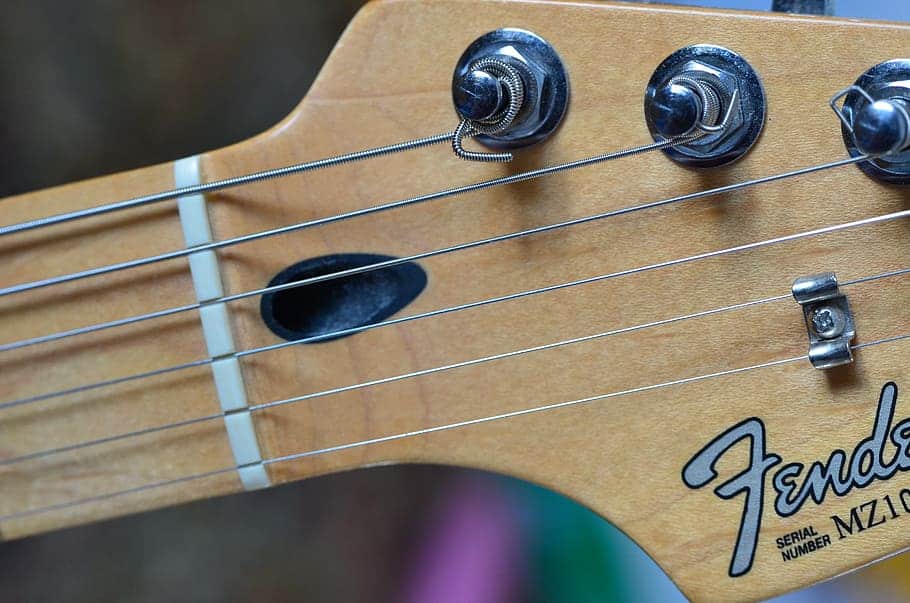The nut of a guitar is that thin bar where the fretboard meets the headstock, where the strings pass through.
It can also be considered the fret zero of the instrument.
But many players argue that this, otherwise forgotten, feature every guitar has is one of its most important and has a big impact on tone and playability.
So do guitar nuts affect tone? Here is a short answer:
Nuts have a big influence on an instrument’s playability, tuning, and tone. Its hardness is what explains how they sound. Better nuts give the guitar a brighter sound. In terms of playability and tuning, nuts affect the action of the guitar, and the amount of friction they exert defines tuning stability.
In this article, for those who want to dive deeper, I will talk about their effect on tone and playability in more detail.
After that, I will list and describe the most common types of guitar nuts, and answer some frequent questions about them.
Finally, I will give you my conclusions and recommendations about how you should approach the decision of getting a new guitar in relation to its nut.
Are you ready to get started?
Let’s go!
What does a guitar nut do?
The nut is the final contact point the strings have with the guitar before getting to the tuners.
Guitar nuts have the function of correctly spacing the strings and procuring them to sit at the correct height. This last thing makes them very important when defining the instrument’s action.
Nuts have slots through which the strings travel and are held in place.
Overall, this part of the guitar acts as an anchor point for the strings.
With properties similar to a guitar’s bridge, both these parts are fundamental for the instrument’s setup, string spacing, and action.
Does a guitar’s nut affect its tone?
The guitar nut is a critical anchor point for the strings and, of course, has a noticeable impact on the instrument’s tone. Its hardness affects the sound in terms of brightness, resonance, and sustain. Different materials are used for the construction of this part and each of them has its own sound profile.
Many players obsess about this particular part of the guitar and it’s a rather cheap and common upgrade to do to more affordable instruments which will help improve their tone, playability, and tuning stability.
How much does a guitar’s nut affect its tone?
Quantifying how much a single part of a guitar can affect its tone is a very hard task. It would require extensive scientific work to arrive at conclusive results.
What I can offer you, however, is empirical evidence, based on the opinion of many players I have reached out to, that form a common consensus.
The guitar nut doesn’t have a deeply impactful effect on those, such as tonewoods or pickups. However, harder materials such as bone or fossil ivory are considered to make the guitar sound brighter and more resonant.
Softer but resonant alternatives such as ebony tend to make for a slightly brighter sound, however, they wear off faster.
Does a guitar’s nut affect its playability?
A guitar’s nut has a great effect on the instrument’s playability. It’s responsible for the spacing of the strings, takes part in the definition of the string action, and has a deep relationship with tuning stability. Better quality nuts will greatly help define and improve all these features.
How much does a guitar’s nut affect its playability?
Guitar nuts have a profound impact on playability, and most tuning issues come from not well-lubricated string sockets. In terms of action, part of it is defined at the bridge, and part of it is defined by the nut. Spacing is solely defined by it and is one of its main purposes.
Most common materials for guitar nuts and their effects on playability, tone, and feel
Guitar nuts come in very different materials, and it’s important to understand how each one works and what makes it a choice to consider.
Here are the most common materials for guitar nuts:
Bone

Bone nuts have been the gold standard for decades in the guitar world. This material has a lot of benefits for this task since it’s very hard and has self-lubricating properties.
Its biggest drawback is its brittleness and its inconsistency having soft pockets of material distributed randomly.
It’s rather easy to work with, but one of its main drawbacks is how expensive it is, compared to other alternatives.
In terms of tone, its hardness gives bone nuts a particularly bright sound that’s sought after by many players.
Fossil Ivory

Fossil Ivory is considered to be the second-best option for a guitar nut. Natural ivory is illegal, but its fossilized alternative is perfectly fine for the job and has characteristics very similar to bone.
If you consider that one of the sources of this material is fossilized wooly mammoth remains, you will agree with me that this is indeed one of the coolest nut materials available.
Its uniqueness surely makes it an expensive and rare to find material while its natural hardness makes it very hard to work on.
In terms of tone, fossil ivory sounds a lot like bone and, as I mentioned, has very similar properties, however, many players claim that the impact this material has on sound is more pronounced.
Plastic

Plastic is the cheapest alternative, as with many other things, available. Many entry-level guitar manufacturers choose this material due to its affordability, availability, and easiness to work with.
Guitars fitted with this kind of nut are due for an upgrade as soon as possible since the upside of swapping it for a better material is considerable both in terms of functionality and tone.
There are, however, higher-end plastic or synthetic alternatives such as TUSQ and Micarta that come very close in every aspect to bone. Of course, these benefits come with a more elevated price tag.
In terms of tone, plastic is at the lower end of the scale. What this material has to offer is very limited, and its functional features don’t compensate for this lack. Price is the only selling point for this material.
Metal

Metal nuts are another particular alternative. The most common within this category are brass and steel-made ones.
Their durability, of course, is exceptional, however, they are difficult to work with, and in terms of tone, they fall short compared to their bone and fossilized ivory counterparts.
They have a particular, rather bright tone that might not be for everyone.
Graphite

Graphite is known for its tuner stability and its tolerance to take a beating from hard players.
It has self-lubricating properties which is always a good feature for its functionality. This makes it one of the lowest friction materials available for nuts.
Some of its drawbacks are that it only comes in black color and that the more affordable options are not quite up there quality-wise.
It is not as durable as bone and fossilized ivory.
In terms of tone, graphite is known to be mellower sounding than the alternatives but also produces slightly less sustain.
Ebony

Ebony nuts look incredible, and although being made of wood, they are rather hard, which is always a good thing for this part.
The material tends to wear off quickly, but its affordability makes it possible to be replaced often. However, this very feature would be a downside for players who don’t like having work done on their instruments regularly.
In terms of tone, ebony offers a nice warm tone, however, they are not as resonant as harder materials such as bone or fossil ivory.
Most common types of guitar nuts and their effects on playability and feel
There are a few different types of guitar nuts that mostly work the same way. However, the difference mostly comes in ways the design tries to compensate for frictional issues that result in tuning problems.
Here are the most common types of guitar nuts:
Standard Nut

It’s the most common type of nut found on the majority of guitars across every price point and date of manufacturing.
Standard nuts work just fine and many players choose them over any of the other more complicated alternatives due to their simplicity and reliability.
Compensated Nut

Compensated nuts are designed to help achieve a better intonation on a per string basis.
As you can see, in contrast with the standard design, each string socket is different, generating alternative effective string distance between the nut and the first fret.
This design works particularly well for improving the intonation of the first frets.
Locking Nut

Locking nuts are commonly used on guitars that have a Floyd Rose floating bridge system.
The concept is fairly simple: There is a series of screw tightened clamps that hold the strings in place at the nut level. This doesn’t allow any movement of the strings at that point.
Its downside is that, when it’s locked, as strings are held tight, you lose the operability of the tuners at the headstock.
Many Floyd Rose versions incorporate small fine tuners at the bridge to allow the player at least some control on tuning.
Roller Nut

Roller nuts are another creative solution to the friction problem nuts inherently have. They incorporate a series of small ball bearings that roll with the strings and greatly reduce resistance.
Strings here sit over the ball bearings which let them freely slide or roll through the nut.
This type of nut is most common on higher-end instruments and is usually paired with locking tuners.
Zero Fret

In zero fret nuts, the nut works only as a string spacer. The point of contact for the strings is an extra fret next to it, which gives it its particular name.
This design, particularly, with the incorporation of that extra fret makes the open strings sound as if they were fretted.
Are bone nuts better?
Bone nuts are considered one of the better materials for the job. Its hardness and easiness to work with make for a great alternative. They are self-lubricating, have superior durability, provide a bright tone and resonance that’s preferred by most players compared to the rest of common materials.
Another rather good material that’s very comparable to bone is fossil ivory, which shares a lot of its characteristics, however, it’s rare to come by and also considerably expensive.
Cheaper options such as plastic high-end alternatives are getting more popular every day.
What is the best type of guitar nut?
The best type of guitar nut, considering the opinion of many players, is bone nuts. They are durable, self lubricate, and sound great. Another nice alternative is fossil ivory which shares almost each of the benefits of bone. A cheaper alternative would be plastic alternatives such as TUSQ or micarta ones.
Being this said, other alternatives such as metal, graphite, and ebony, each have their own upsides and drawbacks and it would be great if you could try them before making a final decision.
Perhaps a less known alternative ends up being better for you.
Conclusions and recommendations
Whether you are looking for a new guitar or planning on building or having one built, getting to know, at least at a high level how nuts work is, in my opinion, something that will help you make a better informed final decision.
However, here in GearAficionado, I always say that you should try out every instrument before buying it if you have the chance.
I don’t think anyone can really understand the sound and feel of all these different kinds of nuts without getting to hear them live. At least try the ones that you think might work out better for you.
If it’s within your reach, try to get to play completely different guitars to clearly understand where the variation lies, and then start checking out ones closer to the one you preferred the most.
Finally, don’t forget to have fun. Technicalities for some people get the joy out of getting a new piece of gear. You don’t have to know it all about something that makes you smile. Just go and play the instrument that feels best to you.

Hello there, my name is Ramiro and I’ve been playing guitar for almost 20 years. I’m obsessed with everything gear-related and I thought it might be worth sharing it. From guitars, pedals, amps, and synths to studio gear and production tips, I hope you find what I post here useful, and I’ll try my best to keep it entertaining also.





